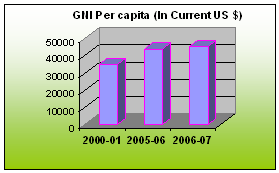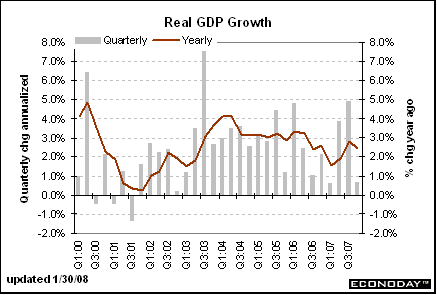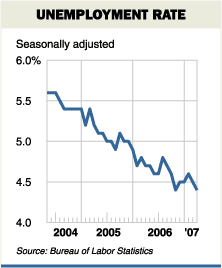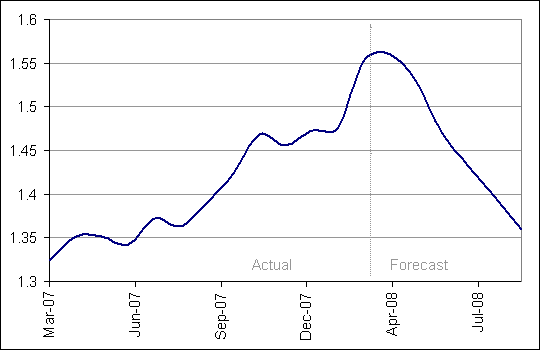Introduction
United States economy is the world’s largest national economy, with an estimated gross domestic product of around $ 13.8 trillion per year. The economy of the United States is a mixed economy under which there are large numbers of private companies with huge net assets valued higher than the GDP of small countries, that can take independent microeconomic decisions that can affect the world economies, despite the fact that there are considerable regulations and involvement by the Government.
Until now the country has maintained a rational level of production per person, and the GDP per capita last year was around $32,700 which was ranked within the top ten highest by most sources. The overall GDP growth rate in the U.S. economy was found stable during all these years, with the considerably low unemployment rate and continuous progress in the research and capital investments, with new innovations and technologies.
According to the Global Competitiveness Report 2007-2008, United States has successfully toped the overall ranking. (The Global Competitiveness Report 2007-2008).
Some of the main economic concerns bothering the United States are, “nationwide debt, entitlement liabilities for retired people like baby boomers, who are incoming Social Security systems, problems like corporate debts, low savings, mortgage debt as also large current account deficits”.
Today, many economists have started thinking that the Economy of the United States is going to face recession and slowly will collapse due to the enormous trade deficits, “off shoring of manufacturing jobs, outsourcing of white collar jobs, the ballooning costs of Social Security and Medicare, the faltering housing market, the credit (sub prime) crunch, the continuously unbalanced budget, and an exponentially rising national debt.”
The problem of the wars in Iraq and Afghanistan will be adding more financial pressures to the economy of the United States of America.
Some economists have predicted that the United States is likely to go bankrupt in a couple of decade’s time. (The predicted economy of USA).
Another major concerns of US economists in recent years were the budget deficit. According to Economist Intelligence Unit, the federal budget deficit will stabilize in fiscal years 2006/07 (October-September) and 2007/08. Since economy and politics are two interdependent concepts, major developments in one may significantly affect the other. The Economist summarizes the political landscape and potential economic consequences as follows: There will be few major policy changes over the next two years, as power is shared by a Republican president, George W Bush, and a Democratic party in control of Congress. The president is becoming more serious about curbing spending growth, after the excesses of previous Republican Congresses, although expenditure on defense, homeland security, and non-discretionary items will continue to rise at a significant, albeit slower, pace. Revenue growth will not take as much of a hit from the slowing economy as was once feared. Except for a modest cut in late 2007, interest rates will remain stable.
GDP growth is forecast to decelerate in 2007 as the housing and manufacturing sectors continue to struggle. Outsourcing manufacturing jobs overseas keep damaging the manufacturing jobs in the USA. In general, although there are still significant problems in losing manufacturing jobs and trade deficit, the US economy looks strong. Political developments in the near future (e.g. presidential elections) may result in minor changes in overall macroeconomic policy.
Gross National Income
The largest and most technologically powerful economy in the world is the United States. The per capita Gross National Income in the country is estimated at more or less $37,610 in recent years, which is appreciably higher when compared with other developed countries.
The graph below shows the continuous increase in Gross National Income per capita in the United States from the year 2000 to 2007. (US Economy).

Gross Domestic Product
In terms of Gross Domestic Product (GDP), United States is in the number one position with a per capita GDP of $43,500. GDP in purchasing power parity of the country is estimated to be. $13.13 trillion in recent years and GDP official exchange rate $13.21 trillion, GDP real growth rate was 3.2% and if we take sector-wise GDP composition in the country, the agriculture sector was 0.9%, the industrial sector showed 20.4% and the services sector GDP percentage was 78.6%. (US Economy Profile 2007).
However, if inside the US economy GDP is taken into account, the year by year GDP growth varied up to 2.5 percent in the fourth quarter, which was down from 2.8 percent in the third quarter as shown in the figure below.
“Higher oil prices led to a jump in the GDP price index to an annualized 2.6 percent, following a 1.0 percent rise in the third quarter.
Real GDP in the third quarter came in at a robust annualized 4.9 and followed a 3.8 percent increase in the second quarter.” (2008 U.S. Economic Events & Analysis).

However, if all over world GDP is considered, even in the terms of GDP also the United States is one of the largest economies in the world.
Jobs and Unemployment
As per the latest news in New York Times dated 5th April 2008, the unemployment rate in the United States had risen to 5.1 percent from 4.8 percent, which is considered to be the highest level from the time when September 2005 amid the aftermath of Gulf Coast hurricanes. (Unemployment hits the fan in the US, March figures show 80,000 more job cuts).
The US state and local government had made efforts for creating more jobs in the year 2007, by hiring approx. 35,000 people. Nevertheless, some of the economists criticized this action, that such things point out a weaker private sector growth, and some other economists said that such actions can prove to be a problem in the long term. However, eventually, this reduced unemployment to some extent.
According to a monthly report of the Labor Department in the year 2007, there showed a healthy job market in the US, with steadily rising wages, and firm job growth resulting in a low unemployment rate. In the year 2007, around 97,000 workers were added by employers and the number of jobless reduced to 4.5% from 4.6%. (Peters).
The US Labor Department reports that the economy added 180,000 payroll jobs in March 2007 up from 113,000 in February. The March figure exceeded the earlier forecast of 135,000. This employment growth shows that the economy is still strong and continues to expand. This increase is mostly due to additional job opportunities in service and some manufacturing industries. Professor Peter Morici from the Robert H. Smith School of Business of the University of Maryland mentions that the economy is adding lots of jobs for college graduates, especially those with technical specialties in finance, health care, education, and engineering. However, for high school graduates without specialized skills or training, jobs offering good pay and benefits remain tough to find. In general, recent unemployment figures agree with the decreasing trend in unemployment since 2004. A figure from Wall Street Journal’s economic outlook page shows this clearly:

Population
As per the World factbook, the overall population of the United States is estimated to be 303,824,646 (July 2008 est.), with an average growth rate of 0.883%. (The World factbook).
In terms of population, the United States is the third-largest country in the world.
The recent data from the US census bureau shows around 295.734 million people residing in the US itself, which is against an average number of 1000 million people living in the high-income countries group.
A vast number of immigrants were attracted by the United States from all around the globe, even then the country is less densely populated compared to other big countries and other industrialized nations.
Output and Demand
The Christian Science Monitor reports that consumer spending rose 4.4 percent in the fourth quarter of 2006. International Herald Tribune summarizes different types of US spending in a concise way. The report surprisingly weak investment spending and relatively strong real consumer spending for the last quarter of 2006. They also point that residential investment spending declined in the fourth quarter. An increase in Government spending especially in federal defense helped the growth of the economy in the fourth quarter.
Inflation and Expectation of Inflation
In the final quarter of 2007, the US economy was seen slowing down sharply, however, inflation then picked up significantly which helped the economy stay. The figure below depicts the inflation rates during the years 2003 to 2007 in the country:

(US Inflation Rate, January 1948 to March 2008).
It was seen that the increase in wages was not considered together with the inflation, which means that the employees actual earning was less than a year earlier. “The average hourly salaries were ticked up 5 percent, or 0.3 percent in March-08, which were running 3.6 per cent higher than a year earlier, but the consumer prices were risen 4 percent over the same period.” Due to this, savings were not encouraged, as inflation affected the increased wages. (Unemployment hits the fan in the US, March figures show 80,000 more job cuts).
In his March 28, 2007 speech in the Congress, Fed Chairman Ben S. Bernanke gives the details for inflation as follows: “Let me now turn to the inflation situation. Overall consumer price inflation has come down since last year, primarily as a result of the deceleration of consumers’ energy costs. The consumer price index (CPI) increased 2.4 percent over the twelve months ending in February, down from 3.6 percent a year earlier” The Economist predicts that inflation will fall in 2007, owing to the slowing economy, but will pick up with the recovery in demand, averaging a rate of 2.4% per year in 2007-2011.
Fiscal Policy
In the United States, the payroll taxes that finance the Social Security and Medicare programs were becoming important, as such programs were day by day growing in the country, and the slow down of the economy was continuously putting pressures on the politicians to burn their heads arguing for various degrees of fiscal expansion and new governmental plans and actions.
“President Bush is close to finding common ground on a fiscal-policy stimulus package to support growth in the US. The package includes temporary tax relief aimed at stimulating consumer and corporate demand. The package is expected to represent approx. 1% of GDP, corresponding to USD 150bn. The main part of it (103bn) is expected to be targeted, to consumers and the rest to the corporate sector.” (Economic Outlook, The US – Fiscal-Policy Stimulus Package).
For the first six months of the fiscal year 2007, which started on Oct. 1, 2006, CNN reports that the budget deficit shrank to $258.43 billion from the year-ago deficit of $302.94 billion. However, they also report a jump in a federal budget deficit of 12.7% from last year’s March to $96.27 billion. The Economist is quite optimistic about the US budget deficit. They said that the federal budget deficit would stabilize in fiscal years 2006/07 (October-September) and 2007/08.
Debts pampering US economy
According to the statement of Hamid Varzi, a noted economist, a huge amount of $2.5 billion is borrowed by the United States from abroad for servicing its escalating debt. “In order to continue borrowing at reasonable interest rates America needs to retain credibility with its overseas creditors, especially Far Eastern nations running huge trade surpluses.” If termination takes place in foreign lending, the Fed will have to forcefully raise the interest rates for attracting money, which will further be responsible for a fall down of the already weak housing market and further bring down the US economy into recession.
Taking into account these facts, countries like China (in particular) are threatened to strike back against US trade sanctions proposals by reducing their $1.3 trillion in dollar holdings. The debts of the US are affecting almost all the nations in different ways, as the “Third world farmers suffer from the effects of gigantic U.S. farm subsidies aimed at reducing the trade deficit, while countries like Russia has actually profited from America’s lack of discipline.” (Varzi).
Interest rates and Inflation
The Federal Reserve is making continuous efforts to combat inflation using various tools, out of which one of the main factors is the interest rate. The Fed tries to raise the interest rates for selling U.S. debts. As more and more people will buy the U.S. debt, more money will be taken out of the economy, which will, in turn, affect inflation. The rate of inflation will come down. And then if people don’t have enough money to spend freely, prices will not further increase, which can hold the inflation rising further.
The Fed will have to raise the interest rates on debts for people to buy the US debts, which will ultimately result in the value of the US dollar increasing.
Therefore if the interest rate rises the US dollar will be strengthened:

However, if for some reason, the Fed does not raise the interest rates, the US dollar will get weakened and decline.

(Jagerson and Hansen).
University of Michigan economists predict that while the economy will expand and more jobs will be available in the years 2007 and 2008, they say interest rates and inflation will rise. The conventional mortgage rate is predicted to rise from 5.9 percent this year to 7 percent in 2006 and to 7.4 percent in 2007. The rate for three-month Treasury bills will increase from 3.2 percent in 2005 to 4.4 percent next year and to 4.7 percent in 2007, while the 10-year Treasury bond rate climbs from 4.4 percent this year to 5.5 percent in 2006 and to 5.9 percent the year after.
Current interest rates are at 4.5% and it is expected to remain this way since the latest unemployment reports in March 2007 show that the US economy added 180,000 jobs.. On top of that, the unemployment rate in March 2007 unexpectedly dropped from 4.5% to 4.4%, the lowest level since October.
Exchange rate: Ireland Business News points out two major developments in the US dollar: Over the past year, the dollar has weakened against the euro, where exchange rate movements have only small effects on exports and imports. Against the important Chinese yuan, the dollar remains too high, and the Yuan sets the pattern for other Asian currencies, which are critical to reducing the non-oil trade deficit and instigating a recovery in manufacturing employment.
The Economist predicts the exchange rates for the next five years as follows:
The below figure depicts the US Dollar to Euro Currency Exchange Rate.
Past Trend Present Value & Future Projection:

(6 Months Forecasts).
Manufacturing & American Economy
According to John Engler, President, National Association of Manufacturers, “The future prospects for the American economy depend heavily on the vitality of U.S. manufacturing”. The total value of the manufacturing sector of the US is so huge that it is bigger than the GDP of the world’s ninth-largest economy. Three-fourths of U.S. exports and the majority of private-sector R&D are from the manufacturing sector. It provides about 13 percent of our GDP. The share of manufacturing towards employment stands at 11%, which has been diminishing over the past decade or so due to rapid advances in technology that have resulted in a reduction of manual labor.
However, the future of U.S. manufacturing is not looking all that rosy. The rise of the South East Asian countries in the global manufacturing competition has prevented US manufacturers from raising prices despite increasing input costs. The government policies are also a reason for the increasing cost of manufacturing. All these factors have made the manufacturing sector increasingly unviable. (US Economy).
The legendary financier, George Soros’ new book – The Credit Crisis of 2008 reveals that “The United States is facing both a recession and a flight from the dollar. The decline in housing prices, the weight of accumulated household debt, and the losses and uncertainties in the banking system threaten to push the economy into a self-reinforcing decline. Measures to combat this threat increases the supply of dollars. At the same time, the flight from the dollar has set up inflationary pressures through higher energy, commodity, and food prices.” (The Economy).
As the European Central Bank wants to maintain price stability, they are not ready to reduce interest rates, this will bring disagreement amongst US & EU monitory policies which will further put increasing pressure on the euro. Then euro is appreciated more than the renminbi, which will create more tensions in trade between Europe & China and finally result in an increase in price in Wal-Mart and put additional pressure on the already struggling U.S. consumer. For declining the house prices, the U.S. government will have to use taxpayers’ money. (The Economy).
Conclusion
China keeps being a major player in the US economy. And, Chinese money keeps being worthless against the US dollar but this hurts the US. Nevertheless, the experts predict there is not any effect in the next six months for the US economy. The Federal Reserve Bank does not have to drop the interest rate because of unemployment. Because according to economist’s unemployment rates are falling and there are some new job possibilities appearing in the country. In my opinion, the Federal Reserve Bank should keep the interest rates like now and the government should try to equilibrate the budget deficit.
The economic growth of the United States has been declining gradually due to the housing slump. The country’s economy is facing rigid competition from the rapidly developing and growing economies like India and China who are coming together with countries like Brazil and Russia in business terms. These four countries, economically christened the BRIC nations, are estimated to be the strongest economies of the world within the next couple of decades. Therefore the United States has to take appropriate actions and reduce its economic problems for the remaining world’s largest economy. The US think tank will have to find a way to balance the various factors that have created havoc in the fiscal outlook of the US in recent years. They have to take steps to curb inflation. Maneuver the interest rate to a level that makes it attractive for the rest of the world but yet reasonable enough to not disturb the domestic market. (US Economy).
Works Cited
The Global Competitiveness Report 2007-2008. World Economic Forum. Web.
The predicted economy of the USA. Phil for Humanity. 2006-2008. Web.
US Economy. Economy Watch. 1999-2008. Web.
US Economy Profile 2007: Economy – Overview. Index Mundi. Web.
U.S. Economic Events & Analysis. Econoday. 2000-2008. Web.
Unemployment hits the fan in the US, March figures show 80,000 more job cuts. New York Times. The Indian Express. 2008. Web.
Peters, Jeremy W. More finding works in the US. New York Times. 2008. Web.
The World fact book. United States. 2008. Web.
US Inflation Rate, 1948 to 2008. NPA. Web.
Economic Outlook, The US – Fiscal-Policy Stimulus Package. Action Forex. 2008. Web.
Varzi, Hamid. A Debt Culture Gone Awry. International Herald Tribune. 2008. Web.
6 Months Forecasts. Financial Forecast Center, 1997-2008. Web.
The Economy. GeorgeSoros.Com. 2007. Web.
Jagerson, John S. and Hansen, Wade. Profiting With Forex: The Most Effective Tools and Techniques. McGraw-Hill Professional. 2008. Web.